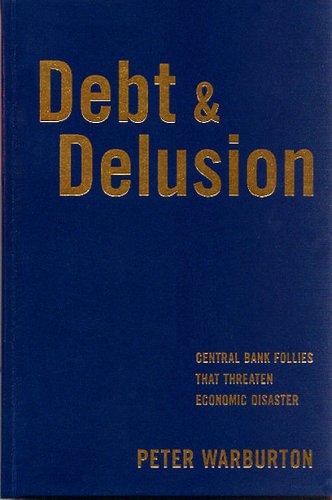[Economic] Videos
Public debt has become a severe problem for a great many economies. While the effects of tax policies on the allocation of resources are readily derived, the mechanisms that make public deficits and debt influence the economy are not so easily understood. This book elaborates on the effects of public debt starting from the intertemporal budget constraint of the government. It is shown under which conditions a government can stick to the intertemporal budget constraint and then, demonstrated how public debt affects the growth process and welfare in market economies. The effects are derived for models with complete labor markets as well as taking into account labor market imperfections. The focus in this book is on fiscal policy issues, but it also deals with monetary policy aspects. The theoretical analysis is complemented with empirical time series analyses on debt sustainability and with panel studies dealing with the relationship between public debt and economic growth.
?Despite clear danger and explicit warnings, the United States of America?distracted by short-term challenges and its own political dysfunction?is steaming toward its own collision, one with long-term debt.”
Philanthropist, businessman, and former secretary of commerce Peter G. Peterson argues that we can no longer ignore the long-term debt challenges facing our country, because our economic future depends on it. The gross federal debt now exceeds $17 trillion and it is expected to rise rapidly in the decades to come. If the growing gap between projected spending and revenues continues to widen, our federal debt is projected to soar to the highest levels in our nation’s history?more than four times its average over the past forty years. This growing debt and the associated interest costs divert resources away from important public and private investments that are critical to our global competitiveness, threatening our future economy.
Peterson has made it his life’s work to bring awareness to America’s key economic and fiscal challenges. He makes clear that if we continue to ignore America’s long-term debt, we will diminish economic opportunities for future generations, weaken our ability to protect the most vulnerable, and undermine the competitive strength of our businesses globally.
The drama-filled, economically damaging budget battles of the last few years have focused almost entirely on the short term?putting aside the more difficult, but much more important, long-term issues. Peterson offers nonpartisan analysis of our economic challenges and a robust set of options for solving our long-term debt problems. He looks at the impact of aging baby boomers, growing healthcare costs, outdated military spending, a flawed tax code, and our divided political system. And he offers hopeful, durable, and achievable solutions for improving our fiscal outlook through a mix of progrowth reform options that would reduce government spending and increase revenue, and could be phased in gradually in the years to come.
There’s still time to restore the United States as a land of opportunity. Peterson’s diagnosis and recommendations can help us confront our fiscal reality, address our long-term debt, and steer the country safely toward a more secure and dynamic economic future.
Book by MacEwan, Arthur
Product Features
- Used Book in Good Condition
Current debates about economic crises typically focus on the role that public debt and debt-fueled public spending play in economic growth. This illuminating and provocative work shows that it is the rapid expansion of private rather than public debt that constrains growth and sparks economic calamities like the financial crisis of 2008.
Relying on the findings of a team of economists, credit expert Richard Vague argues that the Great Depression of the 1930s, the economic collapse of the past decade, and many other sharp downturns around the world were all preceded by a spike in privately held debt. Vague presents an algorithm for predicting crises and argues that China may soon face disaster. Since American debt levels have not declined significantly since 2008, Vague believes that economic growth in the United States will suffer unless banks embrace a policy of debt restructuring.
All informed citizens, but especially those interested in economic policy and history, will want to contend with Vague’s distressing arguments and evidence.
There is an unexploded bomb in the global financial system, threatening to bring the greatest disruption to the lives of people since the Depression on the 1930s. This potential explosion has been created by dereliction of duty by the world’s largest central banks, which have helped to create an unsustainable illusion of personal wealth and national prosperity, exposing the public to uninsurable risks in the process. This volume looks at how this economic timebomb has been created by unchecked credit expansion and the potential havoc it could wreak.
Why do lenders time and again loan money to sovereign borrowers who promptly go bankrupt? When can this type of lending work? As the United States and many European nations struggle with mountains of debt, historical precedents can offer valuable insights. Lending to the Borrower from Hell looks at one famous case–the debts and defaults of Philip II of Spain. Ruling over one of the largest and most powerful empires in history, King Philip defaulted four times. Yet he never lost access to capital markets and could borrow again within a year or two of each default. Exploring the shrewd reasoning of the lenders who continued to offer money, Mauricio Drelichman and Hans-Joachim Voth analyze the lessons from this important historical example.
Using detailed new evidence collected from sixteenth-century archives, Drelichman and Voth examine the incentives and returns of lenders. They provide powerful evidence that in the right situations, lenders not only survive despite defaults–they thrive. Drelichman and Voth also demonstrate that debt markets cope well, despite massive fluctuations in expenditure and revenue, when lending functions like insurance. The authors unearth unique sixteenth-century loan contracts that offered highly effective risk sharing between the king and his lenders, with payment obligations reduced in bad times.
A fascinating story of finance and empire, Lending to the Borrower from Hell offers an intelligent model for keeping economies safe in times of sovereign debt crises and defaults.
Albert Sbragia considers American urban government as an investor whether for building infrastructure or supporting economic development. Over time, such investment has become disconnected from the normal political and administrative processes of local policymaking through the use of special public spending authorities like water and sewer commissions and port, turnpike, and public power authorities.
Sbragia explores how this entrepreneurial activity developed and how federal and state policies facilitated or limited it. She also analyzes the implications of cities creating innovative, special-purpose quasi-governments to circumvent and dilute state control over city finances, diluting their own authority in the process.
Product Features
- Used Book in Good Condition
It’s been almost seven years since I wrote Debt and Delusion. So naturally, readers have a right to ask, “Why produce an updated version at this time?” There are at least three reasons, the cheapest of which is that the author is surprised and flattered to find that it is in demand and there has long ceased to be any supply.
More than that, like an abandoned mine, the book stands as a monument to what was already known about the global credit expansion and the strains in the financial system before the halving of equity market prices from the early 2000 peaks. Most importantly, and sad to say, this equity market trauma foreshadows even more disastrous results of the financial folly that has reached proportions unimaginable in the summer of 1998. And so, the primary function of the book — “as a timely warning of the perils that lie ahead” — remains valid.
Debt and Delusion exposes serious flaws in the development of the global financial system starting in the early 1990s, singling out the world’s largest central banks for special criticism. Their negligent oversight has permitted an explosion of corporate and household credit that has fueled a succession of false markets in stocks, bonds, and property. Alarmed by the monster so created, the U.S. Federal Reserve has spent much of the past five years staving off the evil day when foolish lending turns into bad debt.
Far from being the architects of economic stability and low inflation, the world’s central bankers have ushered in a new era of financial fragility and latent instability. Innovations in the use of derivatives, structured products, and other complex financial instruments have been applauded by the central banks on narrow technical criteria. But these supposed bastions of conservatism have failed to comprehend the wider implications for financial stability.
From poorly documented home loans to sub-prime auto loans to subordinated corporate debt and junk bonds, permanently easy access to credit has compromised economic management in the U.S., U.K., and other English-speaking nations and has fostered an illusion of prosperity and well being.
Lamentably, this staggering collective flight from reason has been endorsed by the economics establishment.
The failure of many of the finest economic minds to engage with the rapid evolution of our financial structures and institutions has led to a superficial assessment of this unprecedented credit experiment. Only now, as various credit markets face the inevitable tests of higher interest rates and the realistic pricing of credit risks, is the threat of a pandemic of debt-related distress beginning to be taken seriously. Government budgets, already strained by the weight of social support, have limited scope to respond.
In short, tougher economic times lie ahead, when personal debts will hang more onerously than for 75 years. Debt and Delusion recommends a hasty! reappraisal of the debt requirements of corporations and households alike.
Peter Warburton
September 2005









